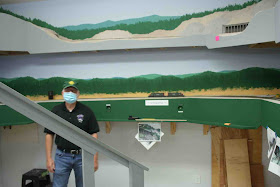As I worked on a nearby track project at the RR-East end of Eugene, I kept bumping over a loose track intended for the scale house at Eugene. It was past time to deal with this simple project!
Railroads charge for most freight on a weight basis. They negotiate various methods of computing or providing the shipment weight with many customers, but some loads simply need to be weighed. Most railroad yards of any significance have a scale track. The scale can be used to determine the empty weight of cars just shopped and to weigh loaded cars as needed. Fairbanks Morse was a major scale manufacturer and their scales often used standardized plans for the scale house.
A few years ago, Walthers produced a kit for a pair of track scales, 933-3199. This kit provides a pair of scale houses and representations of two types of track scales and coverings. The scale house is a simple assembly job. I spent more time painting than assembly. I chose the older style scale covering which was used with a dedicated scale track. The other base features track stand-offs on a "concrete" base intended for closely parallel tracks (about a foot between centerlines) for the scale track and its by-pass. Similarly, the scale houses include one with a peaked roof which I used and one with a flatter roof.
Scale house installed at the RR-East end of my Eugene classification yard.
My scale installation at the RR-East end of my Eugene classification yard includes a straight run-around track and a separate scale track. That latter track was left loose for the past five years as I needed to decide which scale base to use. After years of thinking I would use the concrete base with stand-offs, I finally realized I already made that choice when I laid out the separate scale track. With that settled, it was easy to proceed--at last!
The scale track is the curved track on the far right in this view of the RR-East end of my Eugene Classification Yard.
I quickly assembled the scale house with a peaked roof and then set about painting it into standard Southern Pacific company structure colors. As with my recent effort with the Eugene freight house, I used TruColor paint. I first used white paint for the window mullions. The windows were masked and I applied Tamiya fine surface primer. Next came TruColor TCP-153 SP Colonial Yellow paint. The roof was painted my variation of Moss Green, wherein I lighten the TruColor TCP-154 with white paint at about a 4:1 ratio. Finally, I masked and painted the window and door trim. I used TruColor TCP-163 for the light brown trim. Although I used a fresh bottle and was able to spray the brown trim this time, touch up (almost always needed for trim!) proved difficult as some of the trim brown paint flaked off of the yellow paint underneath. After two serious tries with the TruColor SP Depot Trim Brown, I am about ready to give up any further attempts with this paint for the trim.
A Cotton Belt lumber boxcar= is getting weighed at the new scale house installation.
The track scales feature "wood" planks surrounded by concrete curbing. I began with a couple of spray paint overcoats I use for wood loading docks. I then used multiple washes with thinned acrylic paint in tan, gray, "railroad tie brown," and black. As usual with this sort of wood planking effect, multiple washes are needed to achieve the desired finish. I will now add some car card tags to designate cars to be weighed as they pass through the Eugene Yard.
Scale house and scale coverings.
The scale house is finally done. The track has been installed permanently--no more loose track getting caught by sleeves or simply knocked out of place. The scale house clearly indicates the function of the track immediately in front of it, so I should no longer find the yard crew parking the RR-East switcher on the scale track! As I noted, this was a simple project that waited all too long for completion.










